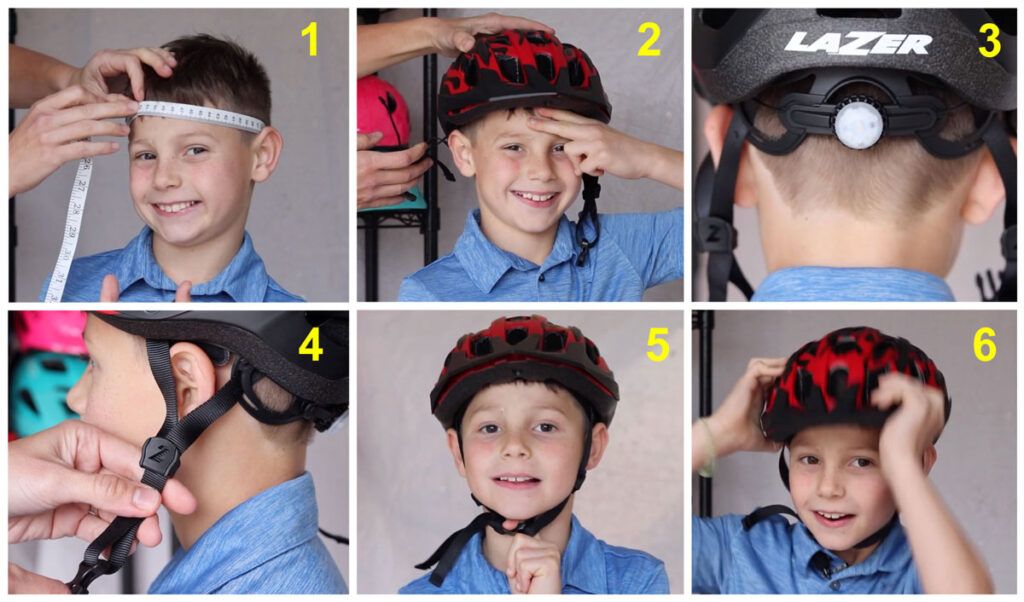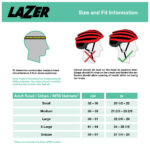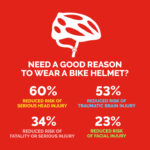A child’s bike helmet should fit snugly, covering the forehead without tilting. Straps must be tight but comfortable.
Ensuring a proper helmet fit for your child is crucial for safety. A well-fitted helmet reduces the risk of head injuries during falls or accidents. Start by measuring your child’s head circumference to select the correct helmet size. Adjust the straps for a snug fit, ensuring the helmet doesn’t move when your child shakes their head.
The helmet should sit level on the head, covering the forehead and not tilting backward or forward. Make sure the chin strap is secure, allowing only one or two fingers to fit between the strap and the chin. This ensures optimal protection and comfort for your child.
Importance Of A Proper Fit
Ensuring a proper fit for a child’s bike helmet is essential. A well-fitted helmet offers crucial safety benefits. It also enhances comfort and usability. Parents must understand the importance of this.
Safety Benefits
A properly fitted helmet can save your child’s life. It protects the head during falls or accidents. The helmet should sit level on the child’s head. It should cover the forehead without tilting. A snug fit prevents the helmet from moving around. This stability ensures maximum protection.
Comfort And Usability
Comfort is key to a child’s willingness to wear a helmet. An uncomfortable helmet will likely be taken off. Proper fit ensures comfort. The helmet should not pinch or cause pressure points. Adjustable straps help achieve a custom fit. Soft padding adds extra comfort.
Usability also improves with a proper fit. Your child can focus on riding safely. They won’t be distracted by an ill-fitting helmet. Easily adjustable helmets are user-friendly. Kids can put them on and take them off effortlessly.
Measuring Your Child’s Head
Measuring your child’s head correctly ensures the bike helmet fits perfectly. A well-fitted helmet provides the best protection. This section will guide you through the process.
Tools Needed
Gather these tools before you start measuring:
- Soft measuring tape
- Pen and paper
- Mirror (optional)
Step-by-step Guide
Follow these steps to measure your child’s head:
- Position the tape: Place the tape above the eyebrows and ears.
- Wrap around: Wrap the tape around the head in a level line.
- Check the fit: Ensure the tape is snug but not tight.
- Read the measurement: Look at the number on the tape. Note it down.
- Double-check: Measure again to confirm accuracy.
Use this measurement to find the correct helmet size. Most helmets have size charts. Match your measurement with the chart to get the right fit.
Choosing The Right Helmet Size
Ensuring your child’s bike helmet fits properly is crucial for safety. A well-fitting helmet provides protection and comfort. Here’s how to choose the right helmet size for your child.
Helmet Size Chart
Using a helmet size chart helps find the perfect fit. Measure your child’s head circumference with a measuring tape. Use the table below to find the right size.
| Head Circumference (cm) | Helmet Size |
|---|---|
| 47 – 52 | XS (Extra Small) |
| 52 – 56 | S (Small) |
| 56 – 60 | M (Medium) |
| 60 – 64 | L (Large) |
Choose the size that matches your child’s head measurement. A helmet should not be too tight or too loose.
Adjustable Helmets
Many helmets have adjustable features. These features provide a better fit for growing children. Look for helmets with adjustable straps and dials.
Here are steps to adjust a helmet:
- Place the helmet on your child’s head.
- Tighten the dial or straps until snug.
- Ensure the helmet sits level on the head.
- Check that the helmet does not wobble.
Adjustable helmets offer flexibility and extended use. They grow with your child, ensuring safety over time.
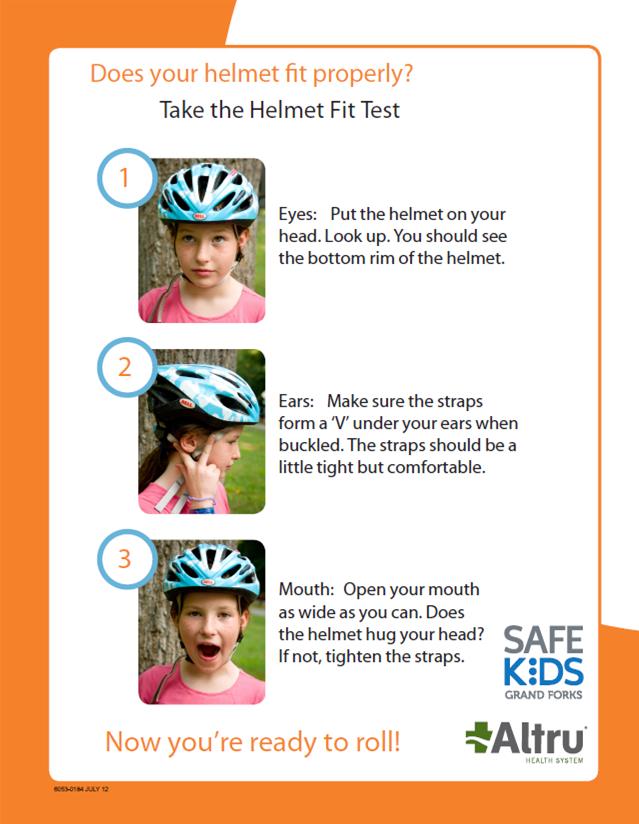
Credit: safekidsgf.com
Positioning The Helmet Correctly
Ensuring your child’s bike helmet fits correctly is crucial. A well-fitted helmet provides maximum protection. This section guides you on positioning the helmet correctly.
Front And Back Alignment
Start by placing the helmet on your child’s head. The front should sit low, just above the eyebrows. This protects the forehead effectively. The back of the helmet should cover the back of the head well. Ensure it does not tilt backward. A helmet that tilts leaves the forehead unprotected.
Side Positioning
Next, check the helmet’s side positioning. The straps should form a “V” shape under each ear. The helmet should sit evenly, not leaning to one side. Both sides should be level and snug. Adjust the straps to achieve this fit. Make sure the helmet does not wobble or slide when your child moves. A stable helmet provides the best protection.
Adjusting Straps And Buckles
Ensuring a child’s bike helmet fits properly is essential for safety. Adjusting the straps and buckles is crucial. A well-fitted helmet will provide maximum protection. Here, we will guide you through adjusting the chin straps and side straps.
Chin Straps
The chin straps should be snug but comfortable. Follow these steps:
- Place the helmet on the child’s head.
- Clip the chin strap buckle under the chin.
- Adjust the length of the strap. Make sure it’s tight enough.
- Ensure the strap forms a “V” shape around the ears.
- Check that only one or two fingers fit under the strap.
Side Straps
Properly adjusting the side straps ensures the helmet stays in place. Use these tips:
- Position the side straps just below the earlobes.
- Make sure both sides are even.
- Adjust the length to keep the helmet centered.
- Ensure the straps are not twisted.
- Test by shaking the head gently. The helmet should not move.
Refer to the table below for a quick checklist:
| Step | Action |
|---|---|
| 1 | Place helmet on head |
| 2 | Clip chin strap |
| 3 | Adjust strap length |
| 4 | Form “V” around ears |
| 5 | Check strap tightness |
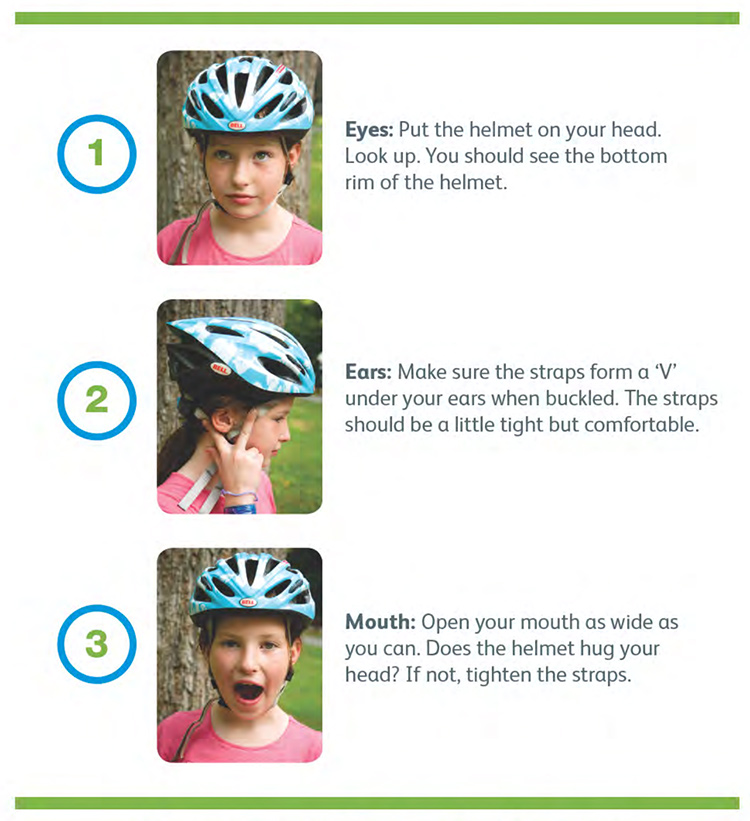
Credit: safekidsgeorgia.org
Checking The Fit
Ensuring a bike helmet fits your child properly is crucial for safety. A well-fitted helmet protects their head from injury. Follow these steps to check the fit effectively.
Shake Test
Once the helmet is on, perform a shake test. Gently shake your child’s head from side to side. The helmet should not move more than an inch. If it does, adjust the straps or padding.
Comfort Check
A helmet should be comfortable. Ask your child if the helmet feels right. It should sit flat on their head, covering the top of the forehead. The straps should form a “V” shape under each ear.
| Comfort Checkpoints | Signs of Good Fit |
|---|---|
| Forehead Coverage | Helmet covers the top of the forehead |
| Strap Position | Straps form a “V” under each ear |
| Chin Strap | Snug but comfortable, with room for one finger |
Common Fitting Mistakes
Ensuring a child’s bike helmet fits correctly is crucial for safety. Many parents make common fitting mistakes that compromise protection. Here, we’ll explore the most frequent errors.
Loose Helmets
A loose helmet can slide around, leaving the head vulnerable. It should sit snugly without moving. Use the following steps to check the fit:
- Place the helmet level on the head.
- Adjust the straps and buckle.
- Ensure the helmet does not move more than an inch.
If the helmet wobbles, it needs tightening. A properly fitted helmet should feel secure but comfortable.
Incorrect Positioning
The position of the helmet is key for protection. Many parents place it too far back or forward. Follow these tips to get it right:
- Level Placement: The helmet should be level on the head.
- Forehead Coverage: It should cover the forehead, about two fingers above the eyebrows.
- Strap Adjustment: Make sure the straps form a “V” under the ears.
A helmet that is too far back exposes the forehead. One that is too forward can block vision. Always check the position before every ride.
Remember, a correctly fitted helmet is the best defense against head injuries.
Maintenance And Replacement
Ensuring your child’s bike helmet is safe requires regular maintenance and timely replacement. A well-maintained helmet provides optimal protection and comfort.
Regular Inspections
Inspect the helmet before every ride. Look for cracks in the outer shell. Check the foam inside for any dents or damage.
Ensure the straps are not frayed or worn out. Adjust the straps so they fit snugly.
Use the table below to keep track of your inspections:
| Date | Checked Parts | Condition | Action Taken |
|---|---|---|---|
| 2023-10-01 | Shell, Foam, Straps | Good | None |
| 2023-10-15 | Shell, Foam | Crack in Shell | Replaced Shell |
When To Replace
Replace the helmet if it has any visible damage. If the helmet has been in an accident, replace it immediately. Even minor impacts can affect safety.
Helmets should be replaced every five years. Over time, materials degrade and offer less protection.
Follow this checklist to know when to replace the helmet:
- Cracks or dents in the shell
- Foam padding is compressed
- Straps are frayed or loose
- Helmet has been in a crash
- Helmet is older than five years
Keep your child safe by maintaining and replacing their helmet as needed. Regular checks ensure the helmet provides the best protection.
Credit: annapolispediatrics.com
Frequently Asked Questions
How Tight Should A Child’s Bike Helmet Be?
A child’s bike helmet should fit snugly but not too tight. It should sit level on the head and not move when shaken.
What Is The Right Position For A Bike Helmet?
The bike helmet should sit level on the head, covering the forehead. It should be about one to two finger-widths above the eyebrows.
How Do I Measure My Child’s Head For A Helmet?
Use a soft tape measure around the largest part of your child’s head, about an inch above the eyebrows. This measurement will help you choose the correct helmet size.
Should A Child’s Bike Helmet Move?
No, a properly fitted helmet should not move more than an inch in any direction. It should stay securely in place during movement.
Conclusion
Ensuring a bike helmet fits your child properly is crucial for safety. Measure their head and adjust straps correctly. A well-fitted helmet boosts confidence and protection. Always check the fit regularly as your child grows. Prioritize safety by choosing the right helmet, ensuring a fun and secure biking experience.
